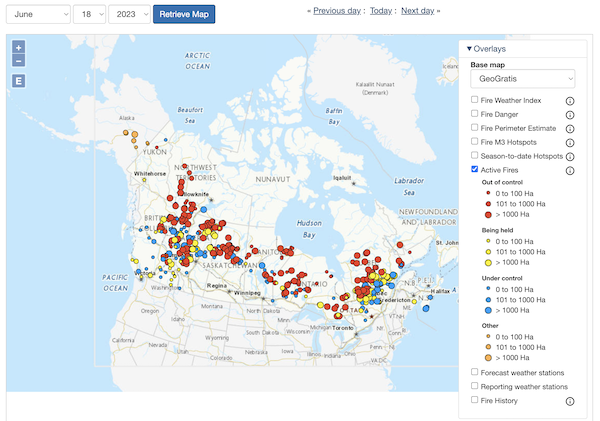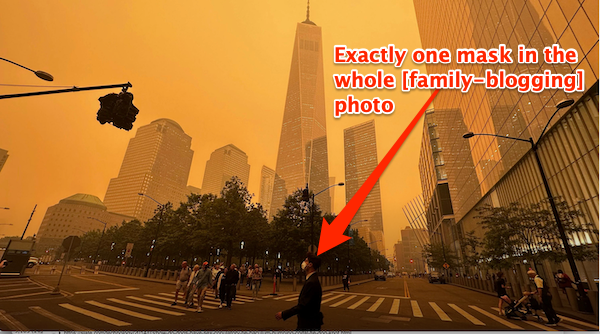By Lambert Strether of Corrente.
“You have not thought things through,” he said. By his standards it was a brutal insult.”
― Ursula K. Le Guin, The Word for World is Forest
introduction
It would be lovely if this were an abstract painting:
But it’s not. It’s a portrait of a Canadian wildfire, one of those that briefly turned New York into the most polluted city in the world, beating out New Delhi. The Canadian wildfires are record-breaking in area:
Canada is on track to exceed the largest total amount of burned area with 2,214 wildfires and 3.3 million hectares burned so far, according to data released June 4 by Natural Resources Canada.
Here is a map that shows their scope, from Natural Resources Canada:

That’s a lot of red dots! Amusingly, the ensuring smoke blanketed the Acela Corridor:

It may, however, be too much to expect that the experience of choking on yellow haze would issue forth in any policy changes.

In any case, the plume has now moved on the flyover.
Ever hopeful, however, I will press on. I will discuss the causes of wildfires, then present one particular cause, as exhibited in three Canadian provinces, and briefly conclude.
Wikipedia defines wildfires as follows:
A wildfire, forest fire, bushfire, wildland fire or rural fire is an unplanned, uncontrolled and unpredictable fire in an area of combustible vegetation.
I don’t see how wildfires can be classified as unpredictable. They are no more unpredictable than the zoonotic tranmission of viruses when humans and other animals live in close proximity (and especially when humans encroach on previously “wild” territory).
That there will be wildfires is thoroughly predictable; the issue is how and where to locate their causes.
One approach is the thoroughly neoliberal message of Smoky the Bear:

Here, the blame cause is located in individual actions; “only you,” and not global warming, or timber industry practices, or even lightning. Good propaganda, but not serious analytically.
A second approach is more sophisticated but no less ideological. From the Government of British Columbia:
The cause of a wildfire is determined by professional investigations. The BC Wildfire Service employs fire origin and cause specialists to conduct investigations in accordance with international standards. They may look for:
- Ignition sources
- Burn patterns
- Physical evidence
- Weather history
Wildfire investigations can be complex and may take weeks or even months to complete.
At least the professionals have moved beyond “only you.” (Other approaches to causality are to blame climate alone or to deny that a problem exists.)
However, we notice that although the professionals “may look for” items on their checklist, there is one item conspicuously absent, that they (apparently) may not look for: Economics. Specifically, the tendency of forest products companies to create monocultures, which burn more easily. From the Natural Resources Defense Council:
The logging industry relies heavily on replanting efforts that create tree stands that are less biologically and structurally diverse and less resilient to future disturbances like extreme weather and climate change than the trees that have been removed. This exacerbates clearcutting impacts because even when these forests regrow, many have been turned into monoculture tree plantations that do not have the same ecological health as intact, multispecies forest ecosystems. One 2012 study argued that ‘the widespread application of even-aged, single species management at all scales of boreal forest management interferes with fundamental ecological processes that maintain ecosystem integrity in boreal forests.’
And:
However, clearcut logging and monoculture replanting often exacerbate wildfires, and studies have shown that intact forest areas experience less severe fires than logged areas.
(The same process has occurred in Europe, for those who remember the enormous eucalyptus fires in Portugal.)
Now, I’ll present examples of forest monocultures[1] in the Canadian provinces of Alberta, Nova Scotia, and Quebec. (I’m saving Quebec for last, because the most impassioned posting was on Quebec, although, interesting, not in the Anglo mainstream press).
First, Alberta. From The Energy Mix:
By killing off all the broad-leafed species, the companies create a monoculture, ‘making a coniferous tree plantation instead of a forest,’ the paper adds.
Forest companies using herbicides and mechanical removal methods to eradicate aspen from the spruce and pine crops they want to harvest are depriving moose of a winter food source and making wildfires more likely in Alberta forests, the Edmonton Journal reports. The clumps and colonies of aspen that grow around Edmonton and northern Alberta ‘are less likely to burn than spruce or pine and cool the forest so well that, when fully-leafed out, wildland firefighters flee to a stand of aspen if the fire unexpectedly shifts,’ the Journal explains.
But “forestry companies consider aspen a weed when growing conifers, spruce or pine. So roughly 30,000 hectares a year of forest are sprayed with glyphosate, the active ingredient in RoundUp. That’s roughly half the size of Edmonton, or 40% of the 80,000 hectares of forest harvested annually” across the province.
So just ask yourself which is more likely to burn: A forest with many species, or one where the timber companies planted hectare after hectare of Christmas trees?
Second, Nova Scotia. From the Halifax Examiner:
“What’s really changed is the condition of our forest,” [professional forester Wade] Prest tells me. “It’s no longer diverse.”
“Our original forest was probably mostly mixed. It tended towards a softwood mix in some areas, and to hardwood mix in others,” Prest explains. Prior to European settlement, he says Wabanaki-Acadian forests would have good canopy coverage, and underneath the canopy it would be generally damp most of the time, without a lot of sunlight getting through to the forest floor.
“And that in itself would be what would stop the fires from either starting or being widespread,” Prest says. “Certainly, the forest has changed.”
“I’ve always been critical of industrial forestry practices, and have vigorously promoted the natural Acadian forest as a model for ecological, social, and economic sustainability for Nova Scotia,” Prest says.
And:
One of the greatest defences that we have against fire risk is diversity … not just of species composition but also age and physical attributes. [Mike Lancaster, coordinator of the Healthy Forest Coalition in Nova Scotia] notes that after World War II and the Vietnam War, there was an explosion in the development of herbicides that were used to kill off deciduous species and manage forests for softwood species industry was looking for.
“It is widely known that conifer forests present a greater forest fire risk than those which are deciduous dominant,” Lancaster says. Because the forestry industry in Nova Scotia has historically been geared to favour coniferous species, in his view, “That translates as an increased forest fire hazard
And finally Quebec, from a long and passionate thread by Peter Gelderloos:
The fires in Quebec are raging in tree plantations that get counted as carbon offsets…. Tree plantations are part of the industrial system of extraction and production. A form of monocrop farming, they are the basis for the profits of the logging industry, which is more in demand as green products proliferate…. Tree plantations are also advantageous because they are fully integrated with the mining industry, using some of the same extraction infrastructure and helping cover up part of the sacrifice zones mining leaves behind….
Most urban people and settlers do not know what a forest is. They see trees, and think it is a forest. .
Governments use the term “forest” without distinguishing between a forest ecosystem and a tree plantation. When I talk about a forest, I’m talking about a robust ecosystem. Granted, non-forests exist on a continuum from monocrop tree plantations planted in rows to post-clearcut regrowth that is managed and commercially harvested..
The forest fires in Quebec and Ontario are originating disproportionately in “managed forest” which are on the continuum of tree plantations.
I wish I could run down the underlined claim by Gelderloos, because laying the fire map on top of the tree plantation map would tie a very neat bow around this post. Alas, I cannot, because the link Gelderloos supplies — here — for the latter map is broken, due to government link rot. Perhaps a kind reader can help?
What I can say is that government policy in Quebec was changed c. 2010 to optimize for ‘management activities for enhanced forest productivity and output value. Hence, the use of plantation will increase in future years, and that, according to Pulp and Paper Canada:
The door is open for large scale tree farming, intensive monocultures and other environmentally non-friendly practices within the “intensive forest management” approach.
Of course, the fool who throws a match into dry timber can “cause” a wildfire. And of course, global warming makes wildfires more likely as well. But in between the individual and the planet is the economic realm — the realm of private property and capital[2] — a third layer of causality which is erased or devalued in all the wildfire coverage I have seen. As the New York Times writes, 26 paragraphs in (!!), in a 2022 article on (so-called) “reforestation”:
A challenge is that helping biodiversity doesn’t offer the financial return of carbon storage or timber markets.
A distinct paucity of excrement, Sherlock! Until we deal with that “challenge,” we will not have “thought things through.” So, nothing “natural” about these disasters at all. What’s “natural” about a timber company?
NOTES
[1] Canada does have standards for forest management, supposedly ecologically sound, but from my very cursory reading, the standards were written with industry concerns top-of-mind, and the whole process was infested with NGOs and carbon offset types.
[2] I had originally hoped to include material on California wildfires and real estate. Perhaps another time.
=


